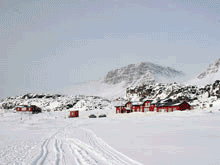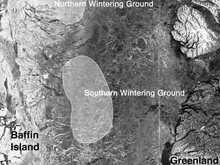Satellite image of sea ice concentration on the narwhal wintering grounds in Baffin Bay, February 2002. Click image for larger view and image credit.
Arctic Climate Change and Narwhals
Dr. Kristin Laidre, Polar Science Center
Applied Physics Lab, University of Washington
Dr. Mads Peter Heide-Jørgensen
Greenland Institute of Natural Resources
The sea around Greenland is known for cyclical climate fluctuations (alternating periods of cooling and warming). The sea temperature in Greenland rose rapidly in the 1920s and remained high until the late 1960s. Then it fluctuated in the 1970s and 1980s, and since the 1990s it has been steadily increasing with the highest temperatures ever recorded in 2005. Between 1952 and 2002, the amount of sea ice increased in Baffin Bay, and the area of open water was reduced. This seems contrary to ‘global warming’ but some regions have cooled or gained more sea ice during climate change (e.g., Baffin Bay). Recent observations (2002-2005) indicate that the 50-year cooling trend may have slowed, or even reversed, and there has been less ice in recent years.
The relationship between narwhals and sea ice is close and has existed for many thousands of years. Narwhals partition their annual cycle between coastal ice-free summering grounds and offshore wintering grounds covered in dense pack ice. During the autumn, fast ice is created in the narwhal’s summering localities. Before sea ice forms, narwhals leave coastal areas and migrate towards Baffin Bay. The migration ends in mid-November when the narwhals arrive in central Baffin Bay. With the exception of fast ice without cracks (ice attached to land), sea ice is not a barrier to the movements of narwhals. Narwhals choose the same wintering grounds year after year independent of sea ice conditions.
Narwhal wintering grounds provide the best opportunity to look at the relationship between a winter whale and sea ice. Narwhals are well adapted to a life in the pack ice as indicated by how little open water there is in their winter habitat. There is often less than 5% open water on the wintering grounds (1 February and 15 April) and minimum estimates are 0.5%. This corresponds to only 150 to 400 km2 of open water available for breathing in a 25,000 km2 large area. The reason narwhals return year after year to an area with such dense sea ice cover is unclear. Although some believe these whales are seeking refuge from killer whales, it is more likely that narwhals need access to predictable prey. Narwhal survival on the northbound spring migration and female condition during calving and nursing in late spring/early summer may depend on food intake during the winter. Therefore the reliable Greenland halibut resources of Baffin Bay provide an attractive food source for surviving the harsh arctic winter.
The winter habitat of the narwhal in Baffin Bay and Davis Strait is generally covered in ice with only a few leads and cracks available for breathing. Click image for larger view and image credit.
Although narwhals spend much of their time in heavy ice, they are vulnerable to unique events called ice entrapments. During an ice entrapment, hundreds of whales might become trapped in a small opening in the sea ice and they often die. This occurs when sudden changes in weather conditions (such as shifts in wind or quick drops in temperature) freeze shut leads and cracks they were using. Narwhals occupy dense pack ice half of every year and they lack any ability to break holes in the ice. There have been no direct observations of narwhal ice entrapments in central Baffin Bay because the area they routinely occupy is hundreds of kilometers from shore and is rarely visited by humans. There are, however, reports of large coastal ice entrapments in areas near where humans live.
It is well documented from ice core samples that the climate around Greenland changed rapidly and drastically many times over the last hundred thousand years. Narwhals evolved as a species sometime during the late Pleistocene (500,000 thousand years ago), a period when temperature and climate changed dramatically. The Pleistocene is also the period where mammoths, mastodons, saber-tooth cats, and many other large mammals and birds evolved and went extinct. Narwhals have survived periods of high environmental variability and glaciations that covered its whole geographic range with ice. In conclusion, increases in the amount of sea ice might exclude winter whales from habitat they are now using. They may also be exposed to increased mortality by sea ice entrapments. Decreases in the amount of sea ice will open new options but a large change in habitat may end up being detrimental to the fish species that the whales need.
References:
Laidre K. L. and M. P. Heide-Jørgensen. 2005. Arctic sea ice trends and narwhal vulnerability. Biological Conservation 121:509-517.
Heide-Jørgensen, M.P., Richard, P., Ramsay, M., Akeeagok, S., 2002. Three recent ice entrapments of Arctic cetaceans in West Greenland and the eastern Canadian High Arctic. NAMMCO Scientific Publications 4, 143-148.
Siegstad, H., Heide-Jørgensen, M.P., 1994. Ice entrapments of narwhals (Monodon monoceros) and white whales (Delphinapterus leucas) in Greenland. Meddeleser om Grønland Bioscience 39, 151-160.


















